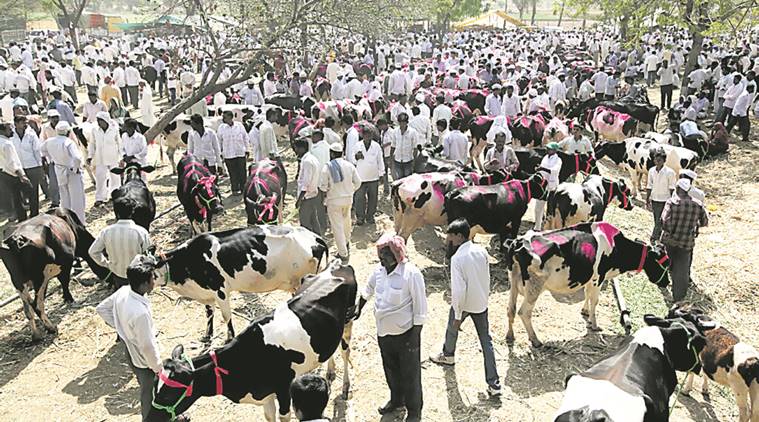On August 14, Sandeep Jadhav joined protestors outside the Ahmednagar district collector’s office raising voices against the apparently growing attacks on gaurakshaks or so-called cattle protectors.
The trigger was an incident on August 6 evening, which saw an armed mob beating up 11 gaurakshaks on the Daund-Pune highway near Shrigonda in Ahmednagar. It happened after the cattle vigilantes, earlier in the day, had intercepted a truck carrying two cows and nine bullocks that were allegedly headed for illegal slaughter. The crowd, gathered under the banner of the Akhil Bhartiya Krishi Goseva Sangh (ABKGS), demanded action both against the perpetrators of the violence and the illegal slaughter activity that was supposedly still rampant in the area.

Jadhav’s being part of the protests had a tinge of irony. A livestock trader from Walki village in Ahmednagar, and mostly operating out of the cattle market at Loni in Rahata taluka of the same district, he has himself been at the receiving end of the gaurakshaks. “They stop trucks of even legally-traded cattle not going for slaughter and for which all the necessary documentation exists. Freeing the seized animals means paying bribes to both the gaurakshaks and the police,” he admits.
Story continues below this ad
Only a couple of weeks ago, gaurakshaks impounded a consignment of eight indigenous Gir breed cows that Jadhav had sourced from a farmer in Gujarat’s Amreli district. These animals, whose milk fetches a premium, are currently being housed at a gaushala (cow shelter) near Amreli. “I paid over Rs 40,000 for each cow. Getting possession of them is going to be a huge challenge. There should be some mechanism where only those engaged in the illegal trade of animals for slaughter are severely dealt with. I totally support such action,” says Jadhav, explaining his participation in the ABKGS-organised demonstration.
Jadhav, who has been in the cattle trade business for two decades, is particularly concerned over the loss of farmer-customers from Gujarat. Prior to the spurt in gaurakshak vigilantism, especially over the last one year and more, he used to sell 35-40 lactating or pregnant cows (mostly Holstein Friesian crossbreds) every week. The buyers were mainly Gujarat farmers.
“Now, I barely do 5-10 animals a week. Farmers have stopped coming due to fear of their vehicles being waylaid by gaurakshaks. Transporters, too, are wary. Those who were charging around Rs 7,000, for hauling four animals on a small Tempo Traveller from Loni to Amreli, are today demanding twice that rate,” complains Jadhav.
His anxiety is shared by other traders of Loni, one of Maharashtra’s biggest cattle market. “Out of the 2,000-odd animals (almost entirely cows) that were traded every week here, a third was being bought by farmers from Valsad, Surat, Bharuch, and Narmada districts of Gujarat. These farmers, who get remunerative prices for the milk they supply to the cooperative unions there, normally purchase in bulk. But their numbers have dwindled to hardly 100 out of a total weekly trade of 600-700 now,” informs Subhash Mote, assistant secretary of the market that meets every Wednesday.
Story continues below this ad
The impact of gaurakshak vigilantism is reflected in the Loni cattle market’s turnover, which recorded a dip from Rs 99.36 crore in 2015-16 to Rs 79.36 crore in 2016-17. Mote does not expect it to cross Rs 50 crore this financial year.
Heightened gaurakshak activism — and, of late, retaliation from a section of those whose business has taken a knock — is clearly linked to the Maharashtra government’s comprehensive ban on slaughter of all cattle, be it cows, bulls, bullocks or female and male calves.
Milind Ekbote, western Maharashtra head of ABKGS, takes significant credit for the effective implementation of the Devendra Fadnavis-led government’s amendment to the Maharashtra Animal Preservation Act of 1976, which received presidential assent in March 2015.
“Our organisation is solely responsible for over 300 cases filed under the new legislation. The police are lethargic in taking action against butchers. Left to themselves, they would have done nothing,” he boasts.
Story continues below this ad
Ekbote, who unsuccessfully contested the recent elections for the Pune Municipal Corporation on a Shiv Sena ticket, denies that ABKGS volunteers stop the transport of animals purchased for milking and breeding purposes. “We never do that. Our target is only illegal trade in cattle intended for slaughter,” he adds.
That claim, however, has few takers among farmers and livestock traders not just in Loni — which is strategically located for catering to buyers both from Gujarat and the adjoining Marathwada region within Maharashtra. A similar situation is being faced by traders in the cattle market of Miraj, a taluka town of southern Maharashtra’s Sangli district.
According to Prakash Patil, secretary of the Miraj market that trades 350-400 animals (both cattle and buffaloes) every week, over a quarter of his buyers come from Karnataka. The gaurakshaks, he states, frequent the market to “observe” the traders. In case someone is “suspected” of purchasing animals for slaughter, police cases are instantly slapped on them.
“We have stopped dealing altogether in old and infirm animals. For the gaurakshaks, any buyer of such animals is a potential cattle smuggler. That fact that Karnataka has no cattle slaughter ban in place does not help either,” he points out.
Story continues below this ad
The ultimate loser isn’t just the market, which has registered a slide in turnover, but also the farmer who no longer has an avenue to dispose of animals that have ceased to give milk or be of use in farming operations.

 A view of the cattle market at Loni in Ahmednagar district of Maharashtra. Express photo by Sandeep Daundkar
A view of the cattle market at Loni in Ahmednagar district of Maharashtra. Express photo by Sandeep Daundkar





